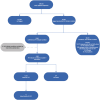Implementing HIV teams sustainably improves HIV indicator condition testing rates in hospitals in the Netherlands: the #aware.hiv clinical trial
- PMID: 40053486
- PMCID: PMC12144530
- DOI: 10.1097/QAD.0000000000004167
Implementing HIV teams sustainably improves HIV indicator condition testing rates in hospitals in the Netherlands: the #aware.hiv clinical trial
Abstract
Objective: Develop and validate a strategy to improve HIV testing rates using HIV teams.
Design: A prospective clinical trial was conducted from January 2020 to July 2023 in two Dutch university hospitals.
Methods: The intervention involved implementing HIV teams to provide peer awareness, education, and feedback to physicians treating patients ≥18 years newly diagnosed with HIV indicator conditions. The primary outcome was the HIV testing rate. Secondary outcomes included testing rates by specialty, HIV prevalence, and reasons for withholding testing.
Results: Of the 313 666 newly registered diagnoses, 2395 involved indicator conditions. The overall HIV testing rate of newly diagnosed HIV indicator conditions increased from 50.1% (222/443) preimplementation to 80.7% (1575/1952) postimplementation of HIV teams ( P < 0.001) with sustained improvement during the observation period (range 72.4-90.4%). The intervention was effective across physicians from all medical specialties. HIV prevalence among those tested was 0.6% [95% confidence interval (CI) 0.3-1.1]. Peer feedback for 411 untested indicator conditions, resulted in 69 (16.3%) additional HIV tests. Failure to test frequently remained without reason (50.6%) or due to patient loss of follow-up (18.4%). Multivariate analysis indicated that women with indicator conditions were tested less often [adjusted odds ratio (aOR) 0.59, 95% CI 0.45-0.79, P < 0.01], and indicator conditions without HIV testing recommendations in national guidelines were also less likely to be tested for HIV (aOR 0.36, 95% CI 0.27-0.48, P < 0.01). For external validation, we implemented this intervention in a second hospital, where it also significantly increased the testing rate postimplementation of HIV teams.
Conclusion: Implementing HIV teams in hospitals is feasible, effective and leads to a sustained increase in HIV indicator condition-guided testing, supporting its broader adoption.
Keywords: HIV; HIV indicator condition; HIV positivity rate; HIV testing; healthcare practitioner; hospital; sexually transmitted infections.
Copyright © 2025 The Author(s). Published by Wolters Kluwer Health, Inc.
Conflict of interest statement
There are no conflicts of interest.
Figures
References
-
- Rodger AJ, Cambiano V, Bruun T, Vernazza P, Collins S, Degen O, et al. . Risk of HIV transmission through condomless sex in serodifferent gay couples with the HIV-positive partner taking suppressive antiretroviral therapy (PARTNER): final results of a multicentre, prospective, observational study. Lancet 2019; 393:2428–2438. - PMC - PubMed
-
- Tominski D, Katchanov J, Driesch D, Daley MB, Liedtke A, Schneider A, et al. . The late-presenting HIV-infected patient 30 years after the introduction of HIV testing: spectrum of opportunistic diseases and missed opportunities for early diagnosis. HIV Med 2017; 18:125–132. - PubMed
-
- Ab E, Bruggeling NM, Donker GA, Posthuma J, Schep A, Stam AJ, et al. NHG-Standaard het soa-consult. 2023.
-
- Europe Hi. HIV indicator conditions: guidance for implementing HIV testing in adults in healthcare settings. 2013.
Publication types
MeSH terms
LinkOut - more resources
Full Text Sources
Medical




